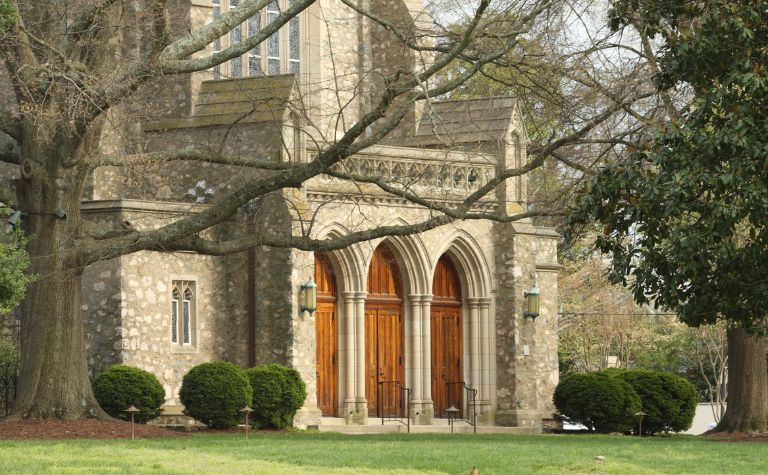The Lutheran and Episcopalian traditions have profoundly impacted Protestant Christianity in Europe, the United States, and worldwide. Yet, these two branches of the Christian faith have similarities and differences, and knowing what those help people to understand their past, present, and future.
The Lutheran and Episcopal traditions originated in separate protests against the Roman Catholic Church in 16th-century Europe. The traditions agree that God is Trinitarian and Christ’s death is an atonement for sin. However, they disagree about church government and the nature of the Lord’s Supper.
What other doctrines and practices do the Lutheran and Episcopal traditions agree about? What do they disagree about? See the comparison charts below for more information.
Also, see the Christian Denominations Comparison Chart to learn more.

Lutheran and Episcopalian: Comparison Chart
People often use the names “Episcopalian,” “Church of England,” and “Anglican” synonymously, though each term is partially unique. In general, they refer to the same historic branch of Christianity.
- Episcopalian: From the Greek word for “overseer” and the Latin word for “bishop,” the term refers to a form of church government that locates ecclesiastical authority in the office of the bishop as opposed to the papacy. People also use the word to identify a person committed to such a church.
- Church of England: The term refers to the Protestant branch Henry VIII and his successors established in England in the 16th century. In America during the Revolutionary War, church members increasingly identified themselves as “Episcopalian” because of tension between the Americans and the English.
- Anglican: From the Latin phrase ecclesia anglicana, the term means the “English Church.” Though this term is less common in America, “Episcopalian” denominations and churches are considered part of the worldwide Anglican communion.
| Lutheran tradition | Episcopalian tradition | |
|---|---|---|
| Founder | Martin Luther (1483-1546) | King Henry VIII (1491-1547) |
| Origin | 16th-century Germany | 16th-century England |
| Early contributors | Philip Melanchthon (1497-1560) | Edward VI (1537-1553), Elizabeth I (1533-1603), Richard Hooker (1554-1600) |
| Important literature | Luther’s shorter and large catechism, the Book on Concord, the Augsburg Confession | The Book of Common Prayer, the 39 Articles of Religion |
| Organization | Churches mainly exist in “communions”; the historic succession of bishops is highly valued; priests and deacons are the other offices in the church. | Churches mainly exist in “communions”; the historic succession of bishops is highly valued; priests and deacons are the other offices in the church. |
| Theological and social worldview | It depends on the synod; the LCMS is conservative; the ELCA is moderate to liberal depending on the congregation* | It depends on the communion; the “Episcopal Church,” the largest communion in the U.S. (est. 2 million) is socially and theologically liberal** |
Various theological topics have divided Lutherans from other Lutherans and Episcopalians from other Episcopalians in the last 150 years. In the late 19th century, one such topic was creation and evolution.
In the early 21st century, some people debated issues related to sexuality and gender. Synods, communions, denominations, and churches have split over these issues. (Also see What Do Lutherans Believe About Divorce?)
* The Evangelical Lutheran Church in America (ELCA), the largest Lutheran synod in the U.S. (est. 4 million), officially supports same-sex marriage and the ordination of people who identify as non-heterosexual. [1]
The largest conservative Lutheran synod in America is the Lutheran Church-Missouri Synod (LCMS) (est. 2 million) believes marriage is between one man and one woman, and supports the ordination of heterosexual men.
** The Episcopal Church in America officially supports and defends issues like same-sex marriage and transgender causes. The communion also realizes that there are congregations that are reserved in this commitment: “The Episcopal Church warmly welcomes our LGBTQ siblings, but it would be ingenuous to say that the entire church is in the same place on this journey. As with all spiritual journeys, everyone walks at their own pace.”
It continues, “Some Episcopal congregations are actively involved in LGBTQ ministry and their arms are open wide; others are more reserved, but their doors are still open to all; some are still wrestling with their beliefs and feelings. But we’re on this journey together, and The Episcopal Church is dedicated to full inclusion and equality in the church as well as in society as a whole.” [2]
Something many people wonder about Christianity is, Do All Denominations Go to Heaven? Follow the link to learn the answer to this critical question.

Lutheran vs. Episcopalian Beliefs, Theology, and Doctrine
The Lutheran tradition is proudly Protestant, and the Episcopalian denomination has roots in the Church of England, in which there has been debate historically over how Catholic they are.
The Church of England traces its history back to the early church, which makes them “Catholic” in the broad sense of the term, but doctrinally they are Protestant.
| Lutheran tradition | Episcopalian tradition | |
|---|---|---|
| Theology (general) | Protestant Christianity | Often considered halfway between Catholic and Protestant |
| Theology (specific) | Conservative synods affirm the authority, inspiration, and inerrancy of Scripture; moderate-liberal synods view the Bible as a helpful guide to belief and practice but imperfect. | Conservative synods affirm the authority, inspiration, and inerrancy of Scripture; moderate-liberal synods view the Bible as a helpful guide to belief and practice but an imperfect one at best. |
| View of the Bible | Conservative synods affirm the authority, inspiration, and inerrancy of Scripture; moderate-liberal synods view the Bible as a helpful guide to belief and practice, but an imperfect one at best | The “low church” (see below) has a high view of Scripture; the “high church” values Scripture plus ecclesiastical tradition |
| View of God | Trinitarian | Trinitarian* |
| View of the Atonement | Conservative synods affirm the truth of the Gospel and believe that Christ took the place of sinners and paid their penalty on the cross; moderate-liberal synods see the death of Christ as an example of dying for something you believe in. | Historical documents make clear that only Christ can save, not works. |
| View of Salvation | Neither Calvinist nor Arminian, but “Lutheran”; conservatives believe in election but don’t define it like Calvinists. | Historical roots are closer to Calvinism than Arminianism; liberal communions are ecumenical and inclusive of other religions. |
| View of the Holy Spirit | Most Lutheran synods and churches are cessationist, meaning they don’t hold to charismatic and Pentecostal expressions of Christianity; some small movements like Lutheran Renewal advocate for continuationism.** | Is historically cessationist; some small communions practice charismatic worship (e.g., International Communion of the Charismatic Episcopal Church) |
Also, see What Do Lutherans Believe? to learn more.

| Lutheran tradition | Episcopalian tradition | |
|---|---|---|
| View of the Church | The Church is the bride of Christ; believers should be regularly involved in the life of a local church, but membership isn’t required for salvation. | The “high church” favors Catholic doctrine and practice; the “low church” favors Protestant doctrine and practice. |
| View of the Ordinances | There are two: baptism and the Lord’s Supper or communion; they don’t automatically convey grace. | There are two: baptism and the Lord’s Supper or communion; they don’t automatically convey grace. |
| View of the Lord’s Supper | The real body and blood of Christ are believed to be “in, with, and under” the bread and cup; this view is often called “consubstantiation.” | Believes in the real presence of Christ; i.e., Christ is present in the elements in some manner, but not in the way Lutherans or Catholics believe. |
| View of the Baptism | Pastors baptize infants who receive the gift of regeneration of the Holy Spirit; faith is necessary for grace to be conveyed (unlike Catholicism) | Clergy baptize infants and adults; baptized individuals are “grafted into the church” [3] |
| View of the end times | Lutheranism is Amillennial, meaning it interprets the 1,000-year period described in Revelation 20:1-6 figuratively and defines it as the time between Christ’s first and second coming (i.e., the Church Age) | Amillennial |
* The first of the 39 Articles reads: “There is but one living and true God, everlasting, without body, parts, or passions; of infinite power, wisdom, and goodness; the Maker, and Preserver of all things both visible and invisible. And in unity of this Godhead there be three Persons, of one substance, power, and eternity; the Father, the Son, and the Holy Ghost.” [4] (Also see Do Lutherans Believe in Predestination?)
* Continuationism and cessationism: Continuationism is the belief that all spiritual gifts, even speaking in tongues and the gift of healing, “continue” today and are operational in the Church. Cessationism is the belief that some spiritual gifts have “ceased” because God only intended their use for the establishment of the Church in the first century. (Also see Do Lutherans Speak in Tongues?)
Please see the related articles below.
References:
[1] Source
[2] Source
[3] Source
[4] Source
[5] Source
Related Articles
Catholic vs. Protestant vs. Orthodox: What's the Difference?
Roman Catholicism, Protestant Christianity, and the Eastern Orthodox Church are the three historical branches of the Christian religion. Each tradition traces its doctrines and practices to the New...
The Lutheran tradition is a 500-year-old branch of Protestant Christianity. Non-denominational churches are a fast-growing segment of evangelical Christianity, especially in the United States and...
